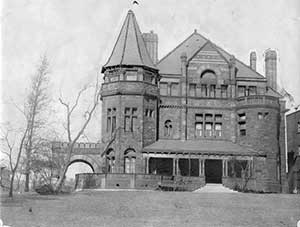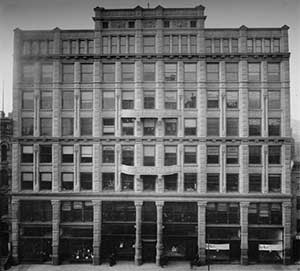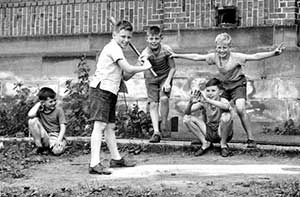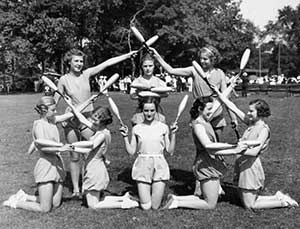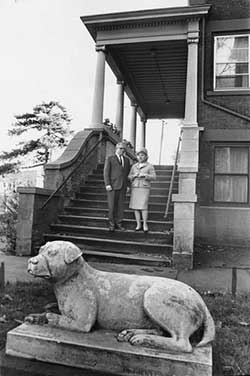German Americans of Cleveland
Featured Topics
This page highlights some of the special and unique people, places and events that best represent the German American contribution to Cleveland's diverse ethnic identity.
For a general overview of German Americans in Cleveland, we suggest:
Charles Frederick Schweinfurth
One of the most influential architects of German descent in Cleveland, Charles Frederick Schweinfurth designed numerous bridges, churches, educational buildings and other structures.
Some of his most well known designs were:
- the Union Club
- Calvary Presbyterian Church
- the Bell Telephone Company Main Office Building
- Trinity Cathedral
- the Mather Mansion at Cleveland State University
- the Florence Harkness Chapel
- Haydn Hall
- the Franklin T. Backus Law School
- the Physics Laboratory and Biology Laboratories at Case Western Reserve University
- the Martin Luther King Boulevard bridge
- the Notre Dame College Administration Building
- the original University School
- the Lakeview Cemetery Entrance on Euclid Avenue.
Schweinfurth completed at least 15 residential designs for prominent Clevelanders on Euclid Avenue's "Millionaires Row". In addition to his own home, he designed homes for William Chisholm, Sylvester T. Everett, Harry K. Hatch, J. Walter McClymond, Amos B. McNairy, George W. Peck, John L. Severance, and Albert L. Withington.
- See Schweinfurth images from the collection
- "Charles Frederick Schweinfurth" entry from Encyclopedia of Cleveland History
Frank E. Cudell
Another well known and important German American architect was Frank E. Cudell of the architectural firm, Cudell and Richardson. Frank E. Cudell and John N. Richardson are best known for their design work of churches and commercial buildings.
The firm designed a series of scared landmarks in the Victorian Gothic style which include the Franklin Circle Christian Church, St. Joseph Catholic Church, and St. Stephan Catholic Church. Their designs for commercial structures included the George Worthington Building, the Perry-Payne Building and the Root & McBride-Bradley Building.
Berea Children's Home
In 1864 the original founding name of the Berea Children's Home and Family Services was the German Methodist Orphan Asylum and was later referred to as the Berea Children's Home. The Home's aim is to preserve family relationships and to create for the child a sense of continuity and security whenever possible.
Over the years the Home has continued to respond to the community's needs through a variety of programs addressing the individual mental health and developmental health needs of infants, children, youth, adults, and families and remains a strong and vital organization.
German Cultural Garden
The German Cultural Garden is one of 23 culturally-themed gardens located along East Blvd. & Martin Luther King Blvd. in University Circle. Planned by the German Cultural Garden Association, designed by Architect Herman Dercum, and dedicated on June 2, 1929, the German Cultural Garden was the third of the 23 gardens to be constructed.
The garden features a twin-figured bronze statue of poet/philosophers Johann Wolfgang Goethe (1749-1832) and Friedrich von Schiller (1759-1805), bronze busts of dramatist Gotthold Ephraim Lessing (1729-1781), and poet Heinrich Heine (1797-1856), as well as a marble fountain dedicated to the memory of Friedrich Froebel, founder of the kindergarten system.
German Day Celebration
The annual German Day celebration in Cleveland was originally inspired by the patriotism of German Americans during the American Revolution. it was first held on August 4, 1890, in honor of when German American troops under the leadership of General Herkheimer assembled for the Battle Oriskany on the same date back in 1777.
Today, as a celebration of pride in being German American, German Day is held in both in October and June. The October program is highlighted by a ball and the crowning of "Miss German Day". The June program features a keynote address by a promonent speaker, entertainment, and the German American Man and Woman of the Year Awards.
Altenheim
Founded by the Westseite Deutscher Frauen Verein (Westside German Ladies Society) as a non-profit facility for the care of the elderly of German American descent, Altenheim first opened its doors at 7719 Detroit Avenue in Cleveland on September 18, 1892. At that time, it accommodated 40 residents, providing them with skilled nursing care based upon a solid foundation of German American values and traditions.
Expanding its vision in 1929, Altenheim removed its nationality and ancestry restrictions to include people of all ethnic and religious backgrounds. In 1980, Altenheim moved to its new Stony Hill Health Center in Strongsville, where it could accommodate 100 residents and in 1991, renovated to expand to its current capacity of 150 beds.
Today, Altenheim is still strongly supported by the German American Community, who take pride in Altenheim's over 100 years service and accomplishment.
- Altenheim website
- "Altenheim" entry from Encyclopedia of Cleveland History
- Read an article from the Cleveland Press

